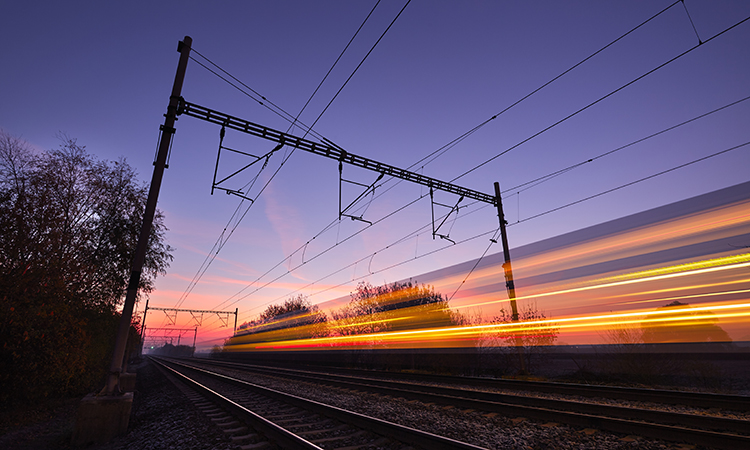Riding the success of rail: The role of the railway in keeping our cities innovative for the future
Posted: 1 June 2023 | UITP | No comments yet
Global Railway Review sits down with the Rail Unit at UITP, the International Association of Public Transport, to discuss the work being carried out alongside their members to drive forward the rail sector.


Metros, trams, regional and suburban rail…all modes playing a leading role in the sustainability efforts of our global cities.
Railways have played a crucial part in the development of urban living for centuries, and throughout that time, they have developed to become among the most reliable solutions for more accessible cities, with cleaner air, and an easier way of life.
To best assess the latest standing in the world of rail, Global Railway Review sat down with the Rail Unit at UITP, the International Association of Public Transport, to discuss the work being carried out alongside their members to drive forward this crucial sector.
Considered by many as the heart of mass transport, connecting towns and suburbs with urban areas where most jobs and services are located, regional and suburban rail is one of the Committees within the UITP Rail Unit.
Whether detailed publications, third-party funded research projects, working bodies, committees, or expert observatories, the UITP Rail Unit covers all topics and trends alongside the world-leading expertise of those with a vested interest in developing innovative solutions for urban mobility.
Now, with the UITP Global Public Transport Summit heading to Barcelona this summer (4-7 June, 2023), the role of the railway will be seen across the impressive week-long agenda. Featuring in the world-leading Exhibition, where numerous rail players will present their latest products and solutions; within the international Congress, led by 300 speakers over 85 sessions, or across the innovative study tours and technical visits…rail will run throughout the Summit agenda.
And through their work, Corentin Wauters, Daria Kuzmina, Giuseppe Rizzi and Salah Regan, coordinate the UITP members active in the rail sector around the world to keep driving forward that expert output.
With new publications, groups and projects, UITP is riding the success of rail all the way to Barcelona and beyond…
Regional and suburban rail rides into the future…
Considered by many as the heart of mass transport, connecting towns and suburbs with urban areas where most jobs and services are located, regional and suburban rail is one of the Committees within the UITP Rail Unit. Comfortable and at speed, it is often regarded as providing the best (if not the only) major alternative to the car in order to travel into our cities and ensure connectivity in rural and low demand areas.
The Regional and Suburban Rail (RSR) Committee is working hard to explore the relevant topics needed to advance the mode, including with several working groups.
The RSR Working Group on Automation in RSR Operations is now active within UITP.
“This particular Working Group has been active since 2021 and is composed of nine members,” Giuseppe Rizzi, Manager of the RSR Committee, said. “The WG is open to experts in automation, and is also joined by non-RSR Committee members. The group is currently working on a report targeted in exploring some automation projects in Europe and beyond, with inputs collected from experiences in other modes like light rail and metros. The topic of automation in depots will also be analysed in this report. This is a cross-modal topic, and members of the Working Group had the opportunity to participate to a technical visit at the Institute of Rail Research in Huddersfield entirely dedicated to this.”
Finding cleaner alternatives to non-electrified RSR operations is another crucial aspect, gaining nowadays more and more popularity due to the increased attention to emissions reductions and clean energies. A Working Group dedicated to exploring cleaner alternatives to diesel traction in non-electrified rail operations will place a special focus on hydrogen and batteries. Several projects are being implemented right now, with the research progressing at speed on these subjects. A report presenting an overview of these alternatives and three different case-studies from Europe is being prepared by the Working Group, together with a workshop dedicated to hydrogen trains.
Finding cleaner alternatives to non-electrified RSR operations is another crucial aspect, gaining nowadays more and more popularity due to the increased attention to emissions reductions and clean energies.
Work is also underway to update the statistics on this mode of transport. Plus, very soon, the floor will be opened up for new members to suggest new topics to work on, keeping the RSR sector researching and advancing on new subjects.
“Next year, UITP will produce a new version of the Regional and Suburban Railways worldwide statistics, a complete compilation of data on RSR, including infrastructure and ridership,” Rizzi concluded. “Some of the RSR Committee members already declared their willingness to contribute to the definition of new indicators. It’s an exciting time for regional and suburban rail, and I’m pleased to be working on all of that output with our members.”
The metro’s major moment…
Metros are very often the fastest and most energy-efficient way to get around a city. They run on electricity and can easily be powered by renewable energy sources. With lines circulating on segregated infrastructure, metros avoid (and help prevent) traffic jams and can transport large amounts of people, making them the backbone of many cities.
Some of the biggest and most well-known cities in the world are renowned for their metro lines. With a unique way of being woven into the fabric of a city’s culture, they can often have a different nickname from city to city.
Within the work being carried out on metros at UITP, the Observatory of Automated Metros is a unique reference for the sector, and tracks developments in this field.
“Fully automated metro operation is four decades old and state-of-the-art in metro systems, but the Observatory, created 15 years ago, continues to monitor trends, research and disseminate information on automated metros,” Corentin Wauters, Head of the Rail Unit at UITP, said. “One of its main topics currently is looking at the automation of existing metro lines, for example looking at the challenges in these complex projects from different perspectives: when is a good moment to do it, economic matters, technical aspects, human resources, and project organisation.”
So important is the metro in the urban mobility landscape, that the working topics on the mode within UITP are extensive.
The Metro Division has four permanent technical subcommittees: Rolling Stock, Fixed Installations, Operations, and Electrical Installations and Safety Systems. The latter also has a permanent working group focusing on communications-based train control (CBTC). In these working bodies, high-level experts from metro operators and asset managers share experience and knowledge on a plethora of topics including, for example: track circuits condition-based maintenance, catenary maintenance, track inspections, fire risk management, customer information, and more.
Light Rail and Trams, the small railway soaring to new heights…
Considered the small railway, light rail and trams do not play a small role in the sustainability of our global cities. With a promising outlook for LRT around the world, the Light Rail Committee within UITP works alongside the relevant members to produce content on the evolution of the sector.
The public transport sector is now living through a special time for light rail and tram systems (LRT), as new developments in infrastructure bring the modes to new heights of success.
“The public transport sector is now living through a special time for light rail and tram systems (LRT), as new developments in infrastructure bring the modes to new heights of success,” Daria Kuzmina, Manager of the LRT Committee within UITP, said. “LRT, at the global level, has experienced a ‘remarkable renaissance’ in recent years, as the international landscape shows growth and expansion on the agenda.”
This expansion of Light Rail systems is monitored by UITP, which has very recently published an update of its global light rail and tram statistics.
The Light Rail Committee works to make sure expectations are met, as interest grows and knowledge is required. With such interest, comes a large agenda. Ongoing work is being carried out to address the challenges and opportunities for light rail, ranging from defining maintenance of the future, track maintenance, and the human resources needs for maintenance.
In addition to making routine operations more autonomous and providing drivers and workshop personnel with opportunities to take on more qualified and diverse roles, Light Rail Committee members are also exploring advanced driver assistance systems and more autonomous operations as a solution to the issue of personnel scarcity in the public transportation industry.
As well as bringing together expertise within the group, the Rail Unit is very active in the field of European research projects. One stand-out project for the Light Rail Committee is R2DATO. Coordinated by SNCF, R2DATO will propose the implementation of ongoing and future innovations in digital and automation technologies for rail operations, including light rail and trams.
“R2Dato is a really exciting project as it will seek to advance automation in railways and leverage digitalisation to make our mobility smarter, more efficient, and greener,” Kuzmina continued. “It began December 2022 and will run until mid-2026 with 27 partners on board. During the Global Summit this June, I’ll be leading sessions on automation in trams, and seeing how we can optimise capacity and operations. Light rail and tram systems hold an important position in the future of our cities and much attention and resources will go into the maintenance, modernisation and replacement of assets to keep ageing systems attractive and fit for operational purpose in the years to come.”
The UITP Summit will also include Conference sessions focusing on brownfield metro and suburban rail automation projects, on improving the total costs of ownership of urban rail systems, on the digitalisation of maintenance and operations, and on the role of suburban railways connecting cities to their hinterland. In addition to this, rail-relevant topics will be entwined in many other parts of the programme via different transversal sessions.
Stations connecting the dots
When we consider the evolution of our cities, it’s also necessary to ensure that they are designed and developed to meet the changing needs of society. With this in mind, UITP has partnered with KONE, a global leader in the elevator and escalator industry, to launch the project Stations of the Future.
“By sharing knowledge and insights, this really exciting project aims to understand what improvements from a passenger’s point of view are needed and how to attract more passengers to public transport and to the stations, focussing on analysing what can be improved in touch points within the passenger journey throughout the station,” Kuzmina concluded. “Additionally, the project seeks to attract attention to the importance of stations in the public transport ecosystem and inspire operators and industry with ideas for solutions.”
From publications, to third-party funded projects, from Working Groups to a full Global Summit agenda, rail runs like a red thread through the output of UITP, and the public transport sector.
Be part of that agenda at the UITP Global Public Transport this June in Barcelona. Click here to find out more.
Related organisations
Related regions
Related people
Corentin Wauters, Daria Kuzmina, Giuseppe Rizzi, Salah Regan








